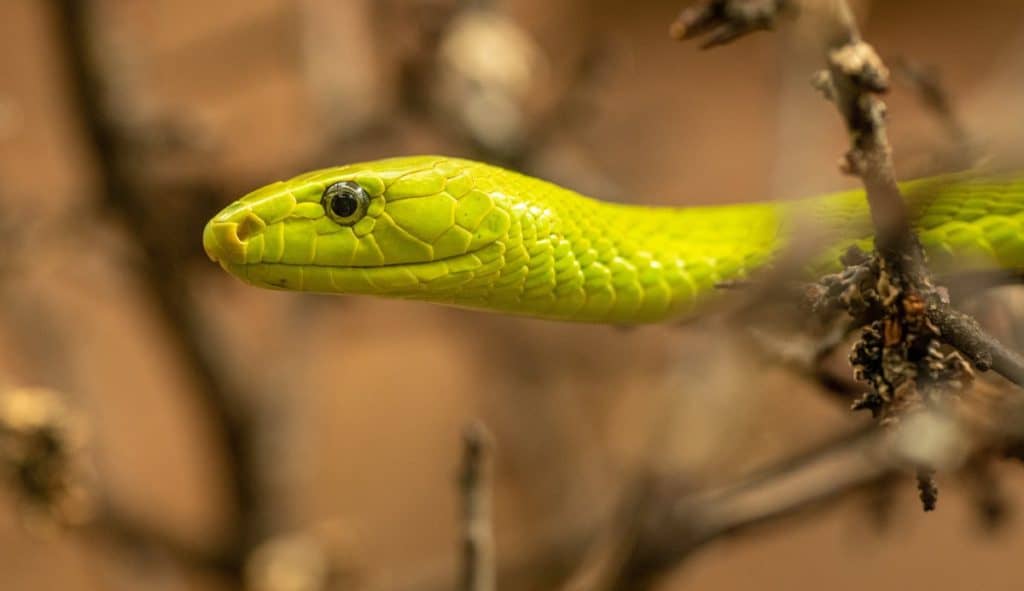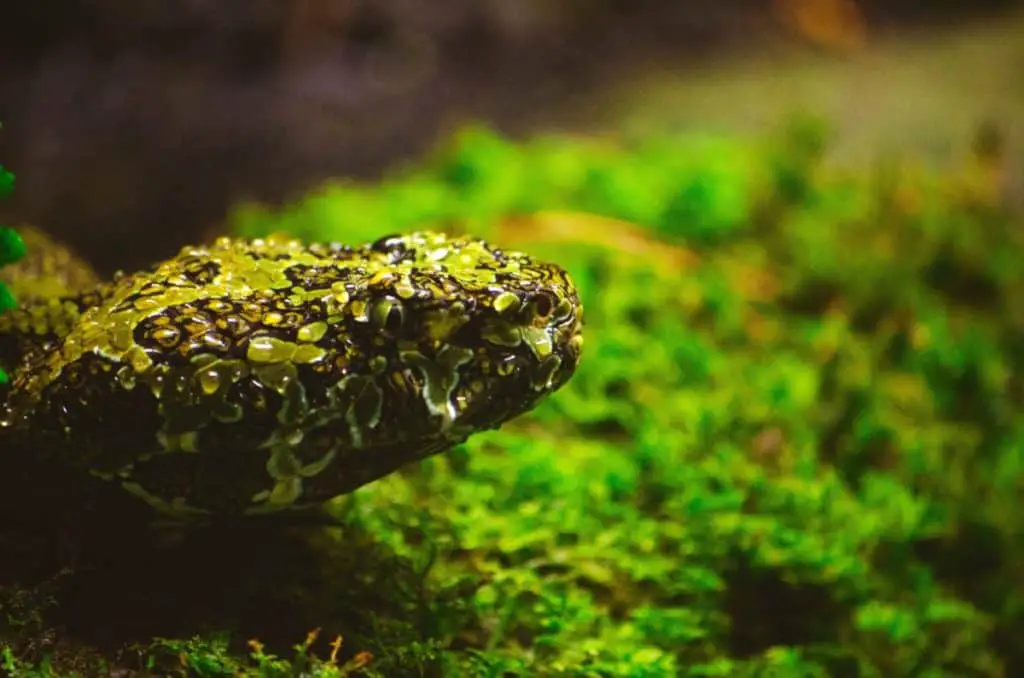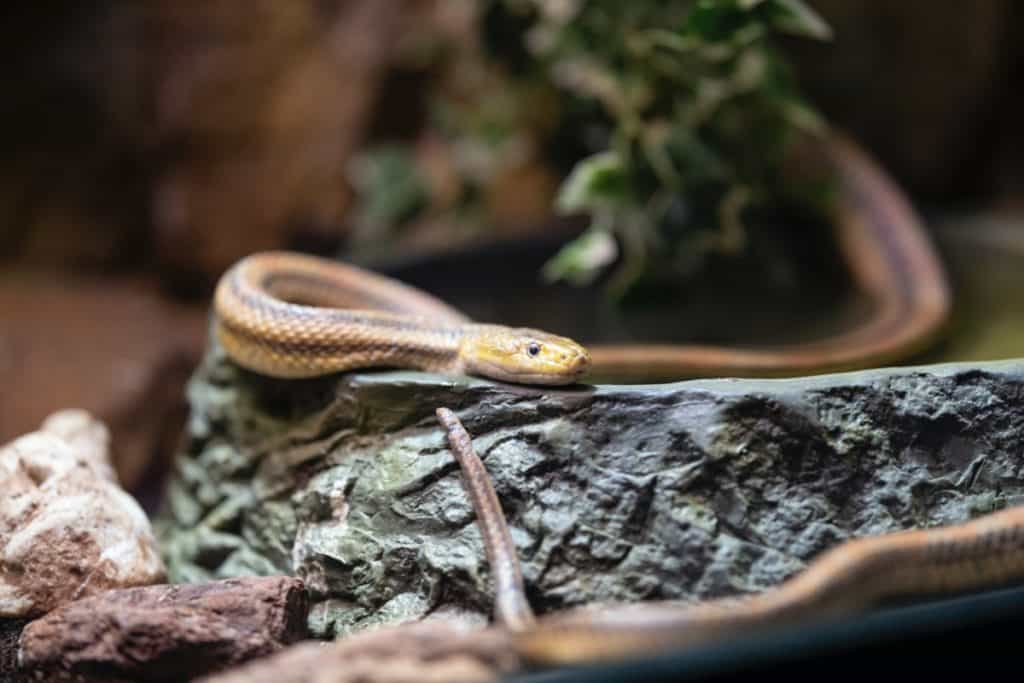
If you were wondering what the weaknesses of snakes are then you’ve come to the right article.
As, in this article, I’ll be answering this question for you and after you’ve read the answer to the main question then I’ll cover a few more answers to closely related questions as well.
I hope you learn a lot from this article!
What are the weaknesses of snakes?
Owing to their constitution, snakes, like all other organisms, have many weaknesses.
Like all animals, snakes are heterotrophic, which means that they must ingest an external food source, hence, they are susceptible to starvation.
Similarly, they require water, so if none is available, they will dehydrate.
Because snakes are ectothermic, they cannot self-regulate their body temperature, rather, they rely on the external environment to maintain a healthy temperature.
Moreover, snakes are not apex predators, so although they are, themselves, predators, they are also preyed upon by other animals, such as eagles and other raptors.
Snakes are more vulnerable to predators when they cannot seek shelter.
For this reason, people who wish to avoid having snakes on their property tend to keep their lawns mowed and clear of debris.
While snakes do not require significant blood flow to remain alive, if they are dismembered or receive a traumatic head injury, they will not survive.
Like most animals, when a snake is injured, it is vulnerable to bacterial infection.
They also often give their position away by hissing or making other sounds.
What are the weaknesses of poisonous snakes?
Like all snakes, poisonous snakes require a source of food, and since they can only eat meat, they will starve in the absence of prey.
While poisonous snakes are dangerous to many kinds of animals, including humans, they are not apex predators; they, too, can fall prey to predators.
Common snake predators include birds of prey, such as eagles and hawks, coyotes, and badgers, all of which can detect snakes by their movements and the sounds they make.
As with other kinds of snakes, lacerations and other injuries can expose poisonous snakes to harmful bacterial infections.
At a population level, poisonous snakes are harmed by the loss of habitat due to industrialization and urbanization.
What are the weaknesses of black rat snakes?
Black rat snakes, or eastern rat snakes, are non-venomous constrictors that can grow up to seven feet in length.
They prey on rodents, birds, and amphibians and are capable of both swimming and climbing.
Although they tend not to be targeted by other animals, like other snakes, black rat snakes are occasionally susceptible to predation by raptors.
Other snakes have also been known to prey on them.
Because they are ectotherms, they have to regulate their internal body temperature by moving between warmer and cooler zones within their environment.
If they are unable to adequately regulate their temperature, they will die.
During the winter, they bromate, though they occasionally awaken to drink water.
As with other snakes, black rat snakes will dehydrate if they are denied access to water.
What are the weaknesses of corn snakes?
Corn snakes are a species of rat snake, which is native to North America.
They are constrictors that lack venom, and they are considered to be a beneficial species since they cull the rodent population.
Corn snakes are vulnerable to predation by birds of prey, and they can be spotted easily by raptors if they are unable to find shelter.
Although they brumate during the winter, if they are caught in an unexpected cold spell during an otherwise warm season, they may become sluggish and less able to evade a predator.
Corn snakes can’t survive if they don’t eat food, corn snakes can’t survive if they don’t drink water, and they often give away their position to predators by hissing or making other sounds.

What are the weaknesses of timber rattlesnakes?
Timber rattlesnakes are venomous pit vipers found in the eastern half of the United States, although its range used to also include the southeastern portion of Canada.
As their name suggests, they tend to be found in dense woodland.
Like all snakes, rattlesnakes can fall prey to predators, such as eagles, owls, hawks, and coyotes.
In the southern US, roadrunners also prey on them.
Their characteristic rattle and hiss can serve to call attention to their location, making them easy targets.
After emerging from their winter dormancy, they can be particularly lethargic and weak.
Like all other snakes, rattlesnakes are ectothermic and need to be able to move between cooler and warmer zones to regulate their internal body temperature.
If they fail to move between cooler and warmer zones then this can be lethal for them.
What are the weaknesses of milk snakes?
Milk snakes are native to southern Canada and the eastern United States.
They are harmless to humans: their teeth are very small and their venom is not poisonous, and they are generally rather docile.
Although they prefer to stay on dry land, they do need to drink water; hence, if none is available, they will dehydrate.
Moreover, like all snakes, they are ectothermic; they cannot self-regulate their body temperature and instead need to move into cooler or warmer areas to do so.
If they are unable to move and thus cannot regulate their temperature, they will eventually die. Like all snakes, they are also susceptible to predation by certain other animals, including birds of prey, such as owls and hawks.
What are the weaknesses of eastern racer snakes?
Eastern racer snakes are a non-venomous species found in North and Central America.
As their name suggests, they are fast-moving snakes.
While many non-venomous snakes are constrictors, eastern racer snakes will either subdue, but not suffocate, their prey or simply eat the prey alive.
Unlike some other species that must avoid open grassland to evade predators, a racer’s agility and speed, not to mention keen eyesight, allows them to hunt in open areas.
Nevertheless, birds of prey will still try to target them.
The main weaknesses of eastern racers are those shared by all snakes: they must be able to move between different temperature zones to regulate their body temperature, they need access to food and water, and they need to avoid infections caused by injuries.
What are the weaknesses of Titanoboas?
Titanoboa was the largest snake to exist, at least as far as we know.
Before going extinct, they lived in what is now northeastern Colombia.
During the period in which they existed following the extinction of the dinosaurs until approximately 23 million years ago, they were the largest apex predator.
In 2009, scientists discovered the fossilized remains of a Titanoboa that they estimated was over 40 feet long and weighed well over 1000 pounds.
They, of course, weren’t able to survive if they didn’t eat food or drink water as well.
The sheer size of Titanoboa would have made them immune to the chief weaknesses faced by other snakes; unlike their smaller counterparts, they did not need to worry about predators.
However, such size brings along weaknesses.
Because they were ectothermic and relied on external environmental conditions to regulate their body temperature, Titanoboa could only survive in high-temperature ranges, specifically between 30 and 35 degrees Celsius, or 86 to 95 degrees Fahrenheit.
Hence, low temperatures would have been deadly and may very well have contributed to their extinction.
Moreover, because of their gigantic size and lack of limbs, they would have moved very slowly.
Why do snakes have weaknesses?
Like all animals, snakes have weaknesses.
Every animal species has evolved to be adapted to a certain set of conditions, if those conditions change too radically, the species will not thrive.
From an evolutionary perspective, species evolve to have traits that make them suitably equipped to compete for resources and reproduce, however, this doesn’t result in a species becoming invulnerable.
Every animal succumbs to death at some point, and in many cases, it is a result of the actions of other organisms, including larger predators or microscopic bacterial organisms.
It is useful to think of an ecosystem and the flora and fauna within it as living in a harmonious balance: when the proverbial scales tip too far in the direction of one species, there are repercussions and, over time, adjustments that have the effect of restoring that balance.

Can snakes get rid of their weaknesses?
Snakes cannot get rid of their weaknesses.
The characteristic weaknesses that snakes have are a function of their constitution.
For example, since they are ectothermic, they become weak and will ultimately die if they are unable to move between cooler and warmer areas as a way of regulating their body temperature.
Moreover, most are susceptible to predation because other species, such as owls and hawks, have developed the capacity to efficiently hunt and kill them.
When a species evolves in a way that can be described as “losing a weakness,” the changes to the ecosystem that result from this will create conditions in which changes on the part of other species will become adaptive.
For example, imagine (contrary to fact) that a particular snake species evolved to detect the flight of a bird of prey that targeted its evolutionary ancestors.
While the evolved species may be able to escape from that predator, given enough time and random variation, it could very well be the case that a new predator species would evolve, which the snake could not detect.
The interplay of evolutionary processes and consequences gives rise to a form of “harmony” within an ecosystem.
When this harmony is disrupted, adjustments occur that have the effect of returning things to a new state of harmony.
Are snakes the weakest among all other predators?
Snakes are for sure not the weakest animals among all predators.
There are many small predators, which are more susceptible to harm and predation than snakes.
For example, grasshopper mice are small rodents that eat insects and even some kinds of snakes.
However, they are also preyed upon by other snakes.
Conclusion
In this article, you’ve learned that snakes have various weaknesses.
They, for example, are heterotrophic which means that they must ingest an external food source which makes them susceptible to starvation.
Also, snakes require water to survive, otherwise, they’ll suffer from dehydration.
Besides, snakes are ectothermic which means that they cannot self-regulate their body temperature, so extreme cold or hot temperatures can be lethal to snakes.
Snakes also have common enemies that will prey on snakes whenever they get the chance and snakes need to make sure that they won’t get injured throughout their lives as these wounds can result in a bacterial infection.
Finally, snakes often give away their position to predators by hissing which can be another weakness of snakes.

